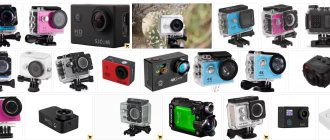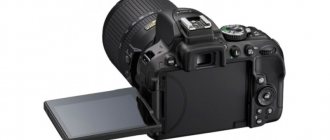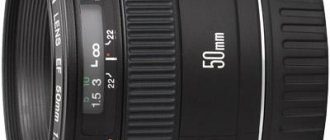Why do you need camera stabilization?
The first photo uses stabilization so it's as clear as possible; The second photo doesn't use stabilization, so it's blurry (photo source: ProPhotos)
Stabilization in a smartphone camera is needed in order to compensate for its movement, avoid blurry photos, as well as annoying shaking in videos. Stabilization is practically irrelevant only if the shooting is done on a tripod and the shutter is released using a remote control. For example, you can remotely control the Camera application on iPhone using the volume buttons on wired and wireless headphones, as well as through the program of the same name on the Apple Watch smart watch. Otherwise, you can’t do without stabilization - the picture will suffer.
By the way, current Apple smartphones are perfect for talking about stabilization. For example, the most popular iPhone 11 has two cameras: wide-angle and ultra-wide-angle. The first is the crown of the manufacturer’s engineering. It takes really high-quality pictures not only due to the relatively large f/1.8 aperture, the relatively large size of the dots on the 12-megapixel matrix, as well as advanced AI algorithms - optical stabilization is also responsible for their clarity. But the second one is here more for show - its aperture is mediocre, and stabilization is only digital.
Using stabilization makes it possible to significantly improve the quality of shooting in the evening, even without a tripod, despite a fairly long shutter speed (photo source: ProPhotos)
Stabilization can be digital, optical, or hybrid - in the latter case we are talking about the simultaneous use of the previous two. Many call stabilization an invisible tripod, which saves photos and videos from the consequences of shaky hands. But it cannot be considered a panacea - yes, it compensates for shaking with a relatively small amplitude. However, if you move quite actively during shooting (for example, dancing), none of the stabilization available on the market will save you. In this case, it will be possible to greatly reduce the shutter speed, but that’s definitely not what we’re talking about today.
What is digital stabilization and what is the principle of its operation?
A schematic example of using digital stabilization with matrix cropping in a modern smartphone camera - the final image will be inside one of the red rectangles (original photo source: Unsplash)
Digital stabilization is also often called electronic stabilization - it is used only because of its simplicity. It does not require any additional hardware components, which increase both the cost and the further cost of the gadget - only those that are already built into the smartphone are used, and software becomes the basis of the technology. Despite this, even digital stabilization significantly improves the quality of photos and videos, so you need to pay increased attention to it. However, to be fair, it is used everywhere today.
Digital stabilization works similarly to perspective correction from Adobe Photoshop (source: Dallas Thomas/Gadget Hacks) - animation available by clicking
Digital stabilization has a fairly simple operating algorithm. Imagine a smartphone camera matrix, which consists of individual pixels - to simplify, let it be a conventional square of 10 by 10 pixels. When stabilization is turned off, the entire sensor area is used during shooting. After its activation, trimming occurs - instead of 10, a couple of points less are used on each side. Based on data from the gyroscope and accelerometer, an 8 by 8 square moves across the camera matrix to compensate for the shaking of the gadget. That's the whole secret.
The first photo shows an imitation of the use of digital stabilization - not all of the image is included in the frame, but it is clearer; The second photo shows simulated shaking without using digital stabilization - the entire image is in the frame, but it is less clear (original photo source: Unsplash)
The number of points each device actually cuts depends on the aggressiveness of the digital stabilization it uses. After cutting the number of pixels, the image quality also drops - the more aggressive the stabilization is, the stronger it is. However, most often this is justified by the absence of smeared areas. Previously, there was more talk about digital stabilization, but today, without the help of optical stabilization, it is left only in inexpensive smartphones.
What is optical stabilization and what is the principle of its operation?
Schematic representation of the operation of optical stabilization, in which shaking is compensated by the movement of the camera itself using a special hardware mechanism (original photo source: The Verge)
Despite the fact that not all cameras of modern smartphones use optical stabilization, this technology is far from new - to be more precise, it is at least a quarter of a century old. Back in 1995, Canon began using it in its cameras and lenses. Its version is called Image Stabilization (IS), so other companies had to come up with their own names: Vibration Reduction (VR) for Nikon, Optical SteadyShot (OSS) for Sony, Optical Image Stabilizer (OIS) for Fujifilm. The Nokia Lumia 920 from 2012 is considered to be the first smartphone with an optical stabilization system.
The operating principle of optical stabilization is clear (source: Inam Ghafoor/YouTube) - animation is available by clicking
To use the capabilities of optical stabilization, the smartphone camera uses a special moving mechanism that moves not the image across the matrix, but the entire matrix. As a result, the picture remains sharp, despite the shaking. However, you cannot rely 100% on optical stabilization either. It should be noted that each camera manufacturer has its own ideas about how optical stabilization works, so the quality of the result in the form of a photograph can vary quite a lot. Moreover, camera movement is also limited, so stabilization only compensates for slight shake.
DJI Osmo Mobile 3 is a steadicam for mobile devices that will significantly improve image stabilization (photo source: DJI)
Optical stabilization
This is a hardware method for solving image quality problems. To use its capabilities, a special moving mechanism is installed in the smartphone camera, which moves not the image across the matrix, but the entire matrix. To correct the image, sensors are used that determine the oblique displacement and deviation. The information obtained is used to make the necessary shifts for the entire module, as well as the image sensor and lenses.
This function is of high quality in long exposure and low light conditions. However, it affects the aperture ratio, compensates only for slight shaking and is more expensive.
Which is better: optical or digital stabilization
Compared to digital, optical stabilization clearly wins. To begin with, it does not cut off the use of the matrix, so the image is brighter, clearer, with less noise, and so on. Moreover, most often optical stabilization plays out the process of shaking compensation much more correctly, because it does not read data from the gyroscope or accelerometer, but uses its own hardware mechanisms. Optical stabilization is not even used in the newest smartphones - for example, it is in the Xiaomi Mi5, which is already several years old.
Interesting fact: some
consider
that digital stabilization is better than optical stabilization when shooting video. For example, it is used in the first generation of Pixel smartphones, and Google representatives explain this by the fact that it is able to predict movement, so it compensates for it noticeably faster - this is critical when shooting videos. However, in the second generation Pixel, engineers are already using hybrid stabilization, about which further.
Optical or digital stabilizer - which is better?
There can't be two different options here. Definitely, optical image stabilization is always better. According to tests (which ones we don’t know, we’re just saying so) it shows the best results. And in general, it’s easy to verify this yourself. You just need 2 cameras with different stabilization systems. Take pictures with each of them, but at the same time shaking the camera itself a little in your hands. The result will be obvious.
Cameras with an optical stabilization system are more expensive, and the price difference is completely justified. If you have the choice between a camera with digital or optical stabilization, it is always better to choose the latter option.
Please rate the article:
Join on Telegram
What is hybrid stabilization and what is the principle of its operation?
Google uses hybrid stabilization in Pixel 4 - and in two smartphone cameras at once (photo source: Genk)
A striking example of a smartphone that uses hybrid image stabilization is the Google Pixel 4. It involves combining the capabilities of digital and optical mechanisms, which allows you to make the picture as clear as possible and avoid blur even in the most active shooting conditions. As planned, such a gadget should always use optical stabilization, and connect digital stabilization either using an additional function or independently in an intelligent way. Theoretically, such a mechanism should significantly increase the effectiveness of stabilization.
Conclusion
The article describes in detail image stabilization in a smartphone. Optical stabilization is better for taking photos, and digital stabilization is better for recording video. At the same time, the cost of optical stabilization does not allow us to equip all smartphones on a large scale without exception. But we can implement the digital method on smartphones of all price categories without significant costs for the manufacturer. If your smartphone does not have stabilization, tripods or steadicams will help solve the problem.
What kind of stabilization is in your smartphone? Share your opinion in the comments below the article.
Post Views: 383
Which stabilization is better?
Typical mobile photo scenario (photo source: Android Central)
To answer this question, you need to answer this: under what conditions is a photograph usually taken or video recorded on a mobile device? And one more thing: how much does its owner bother to achieve a high-quality picture? The answer is simple - the user wants to receive pictures and videos of maximum quality without putting any effort into it. Hence the rather simple conclusion - the gadget should have the best possible camera that will use hybrid stabilization. By the way, here is a clear example of shooting on the “bearded” Google Pixel 2 with and without it:
The result is obvious: without stabilization the video looks simply disgusting, but with it it is quite suitable for further use. It is worth noting that in this case the conditions are as extreme as possible. On the one hand, it is difficult for the camera due to shaking. On the other hand, it must cover a wide dynamic range due to the rather complex composition of the frame in terms of light. Of course, it’s difficult to say that Google Pixel 2 did a perfect job in this regard, but we’re talking about global picture quality, namely the difference when using hybrid stabilization.
How to reduce vibration in a camera?
It’s not enough to say that a camera with a stabilizer should be a priority. Don't hesitate to take this one! In the end, this function can be turned off, and it is even recommended to do so, for example, when using a tripod. But you are unlikely to want to part with it.
You begin to understand the meaning of stabilization immediately when you compare pictures with and without it. Of course, if it is missing, this is not a death sentence, and many cameras do not have it. But this does not mean that the camera is not worth buying because of this.
A stabilizer is a device inside the camera, the work of which is aimed at combating vibrations during the shooting process, eliminating possible interference in the photograph due to camera movement
The blur of the frame cannot always be noticed during the photography process, especially when it is small, but if you look at every detail on the computer, then most likely something will be fuzzy or as if in a fog. These are the consequences of destabilization.
Naturally, a photographer's stability is not always ideal. Your hands may shake a little, there may be vibrations from the ground or highway, it may be windy outside, etc.
A tripod, as well as manipulations with light sensitivity and shutter speed, are convenient only in some cases, but they are not without their drawbacks.
Reducing noise, adding sharpness to a frame, and much more can be achieved by processing in editors, but don’t you regret wasting your time on these little things? It is best to have a stabilization system built into the device.
The stabilization control can be placed on the side of the lens or in the menu if the stabilizer is digital.
Let's take a closer look at the options for camera stabilizers and their features.
What are the prospects for stabilizing mobile device cameras?
VIVO APEX 2021 concept phone, which uses a camera with a highly upgraded optical stabilization mechanism (photo source: Matrix Life)
There are three equivalent development paths for image stabilization in smartphone cameras. Firstly, its optical mechanisms are becoming more and more accessible, therefore they are increasing the width of their distribution not only in smartphones, but also in the cameras in them - so, you see, all the modules of future iPhones will work with it. Secondly, more advanced optical stabilization mechanisms will appear, which are already appearing in concept phones - the same VIVO APEX 2020 (it uses a gimbal stabilization mechanism that increases the amplitude of camera movement to compensate for even the most aggressive shaking). Thirdly, we cannot throw aside intelligent software mechanisms that continue to develop.
How does image stabilization work?
Image stabilization in lenses is achieved through the use of a floating lens element. Your camera senses this floating element moving inside the lens. The element is then moved by the lens electronics in the direction opposite to camera shake.
In-camera stabilization works by actually shifting the sensor slightly to account for camera shake.
There is no definitive answer to the question of which is better, lens-based stabilization or in-camera image stabilization. Each has its own pros and cons (this is a separate topic).
The benefit of image stabilization is that it allows you to capture clearer images of stationary subjects with slower shutter speeds than without it. Lens manufacturers rate image stabilization based on what shutter speed you can shoot at with image stabilization.
Let's take a closer look using the Nikon 24-120mm f/4 lens as an example.
Nikon rates vibration reduction capabilities at 4 stops. Without image stabilization, you would have to shoot static subjects at a shutter speed of at least 1/125 to avoid blur in your images from camera shake. With VR enabled on the lens, you can hold the lens and shoot at 1/15 second speed.
This is a powerful thing if you're shooting stationary subjects in low light conditions. Below are two photos, the first was taken with IS image stabilization and the second was without it. It can be clearly seen that image stabilization has helped the image quality.











